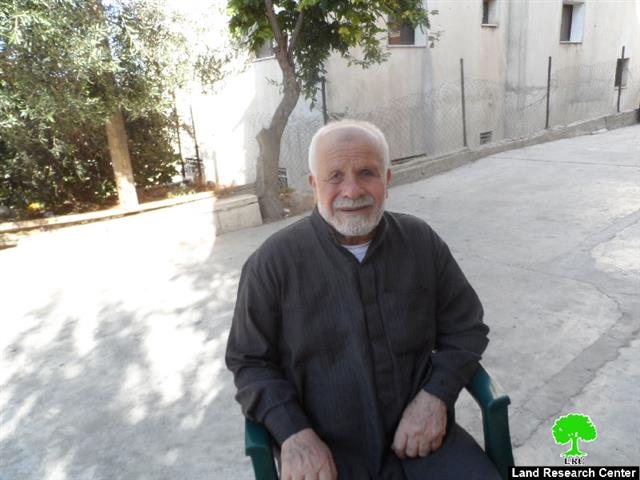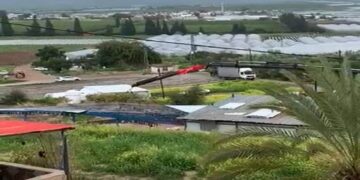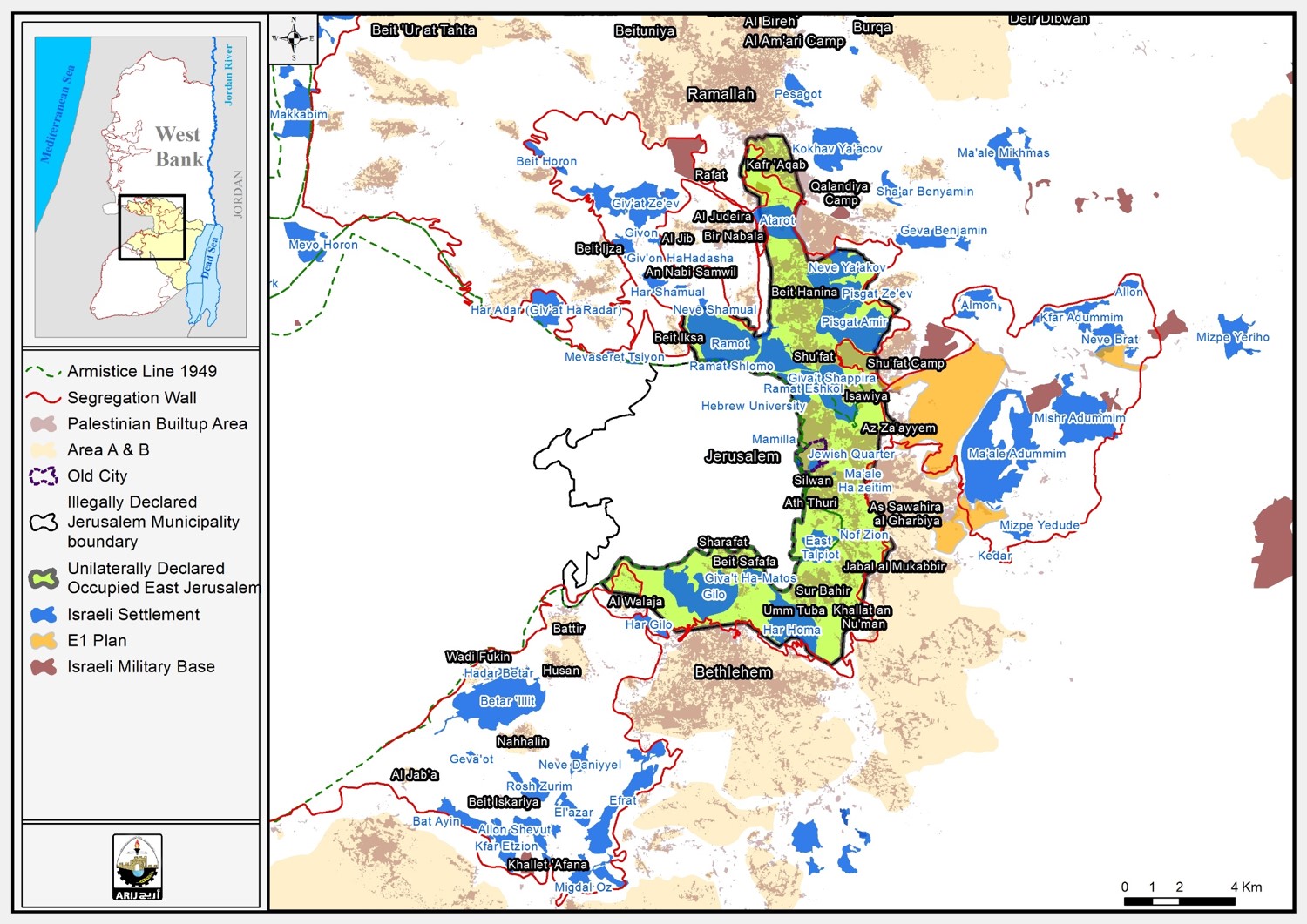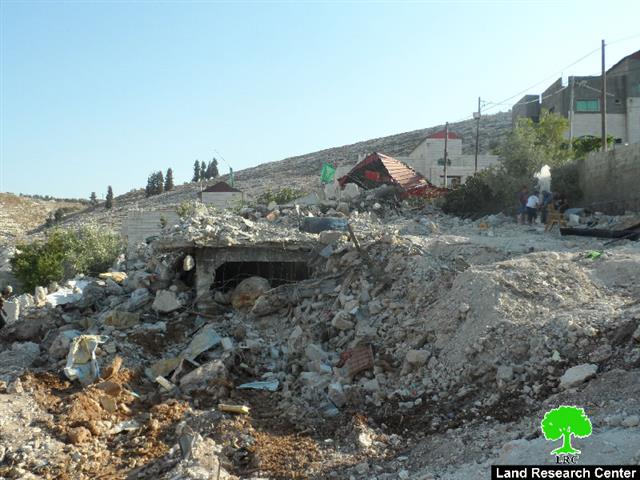Since the occupation of the West Bank in 1967, the successive governments of Israel conducted a policy that aims at taking over the area’s resources. The policy is represented in stealing lands and turning them into military closed zone or absentees’ properties to implement colonial projects.
AbdelRahman Qasim , who is from the Ramallah village of Dura Al-Qur’ and in his late seventy is an icon of steadfastness against the Israeli conspiracy to take over his land; which is and Israeli policy of Judaization through creating a forged history on the lands.
In an interview with Land Research Center, Qasim to the researcher, about his long agony, said: “I have an ownership document on my 14.222 dunums plot from Israel Civil Administration; the document sates that the land is registered under my father’s name and that I am one of the official heirs of the property and have legally the right to dispose on the land, which is located within the natural block no.4 of the plot no, 142”.
He also said: “I have been planting the land with wheat, figs, grape and olive since I was a kid; it is the only source of income to support my 7 member family. This all changed by the year 1981 when the Settlement Council of Beit El (120m away from my plot)started harassing me by cutting down tree, sabotaging my crops and sending me out of the land. Despite all harassments, I insisted on taking care of my land”
He continued saying: “Harassments stopped by the year 1984 when the commander of the army in the West Bank issued a military order declaring 60 dunums of lands including mine “closed military zones”, which were later fenced. The occupation claimed giving us a 45 day deadline to object to the order but I did not take action, taking into account that I was not delivered the order and I only knew about it after the objection period was over. Ever since that date, I was denied the right to access my land”.
Qasim added: “I did not find any guidance in that regard until I was informed about Al-Haq organization in 1986, through which I objected to the order but our objection was rejected for it was not submitted within the legal deadline (45)days. In 1990, colonists built two structures on the edges of my land and I also didn’t find any Palestinian body that could help me. In 2009, colonists laid foundation for two buildings so I tried to stand up for them for the land is mine”
He also added: “I sought help from Yesh Din legal organization, which commissioned attorney Mohammad Shuqair to follow up on the case; the complaint was submitted to Benyamin Police Station, north Jerusalem in 2009. Noteworthy, the complaint was supported by the ownership documents I have. The responsible detective formed an inspection committee with the Settlement Council of Beit El to consider the submitted complaint. A field inspection visit was appointed to take place in presence of the following (Benyamin Police, responsible of Beit El Settlement council, the chairman of Dura Al-Qar’ village council and I). The responsible of the Settlement Council claimed that the documents I have were forged but was surprised to find out that they were issued by the court of Beit El itself. As a result, the complaint was approved and filed to Israel Supreme Court through Benyamin Police Station. On January 2010, the court made a decision rendering a halt of construction on the two buildings. The decision was not respected by colonists, who continued the construction works. Thus, I submitted another complaint to Benyamin Police station, which fenced the area and sent the contractor out of my land”
Qasim added saying: “As per fencing the construction work, colonists submitted a plea to the Supreme court. A number of Israeli bodies and officials supported colonists in this regard including (Minister of Defense, the West Bank Army Commander, Police Station of Judea and Samaria district and the West Bank Civil Administration). The aforementioned signed a petition to complete the construction of the two building. Over a period of five years and five court sessions, colonists failed at obtaining a decision despite seeking the help of the Israeli Parliament. Noteworthy, I couldn’t attend four out of the five sessions for the Civil Administration rejected my entry permit despite an official letter from the Supreme Court, which stated the issuance of a permit for me. I finally managed to obtain a permit with help of Palestine Ministry of Civil Affairs only 30 minutes before the session started. The attorney waited for me at Qalandiya crossing, from which we headed to the court. At the end of the session, the court ordered the two buildings to be demolished within a 9 month deadline. The Israeli supporting bodies and officials tried to submit a plea for the decision and also attempted to buy my land for an amount of 2 million INS ($509,000) for each single dunum. The final plea was rendered rejected and demolition took place on July 30, 2015”.
Photos 2-5: the decision made by Israel Supreme Court

Photo 6: the ownership document of Abdel Rahim Qasim’s land that was taken by Beit El colonists/Dura Al-Qar’
It is indicated that Qasim tried to submit a complaint against the two buildings founded on his land in 1990 but the court rejected the complaint for the two building were built 20 years ago.
It should be also marked that Qasim is still denied access to his land that is confiscated for military purposes by the occupation. The land is reported to be located in the lap of Beit El colony, which makes it impossible for Qasim to access it, fearing to be attacked by colonists.
The Israeli government in a session conducted on July 27, 2015 approved the construction of 300 colonial units in the colony of Beit El to please the upset colonists.

Photos 7-9: the two colonial buildings founded on Qasim’s land
Photo 10: the two buildings after demolition
Outcomes:
- The ownership document of Qasim’s land is the same paper most of the lands’ owners in the villages of Dura Al-Qar’, Ein Yabrud and Silwad have. But the only difference is that Qasim was authorized by other heirs to run the affairs of the land. Those who don’t have authorization paper by heirs couldn’t object to orders served on their lands.
- Based on the aforementioned and according to the acknowledgment of the Israeli judicial system, all of the Israeli colonies are located on Palestinian private lands.
- This case showed that Israeli bodies and officials are part of a fraud system that forge documents and change facts to take over Palestinian lands.
- Approving the construction of new 300 colonial units by the Israeli government before demolishing 2 buildings is an undermining of the decision made by Israel Supreme Court.
- The demolition of the two buildings didn’t give the lands back to its owner.
Prepared by
The Land Research Center
LRC



















